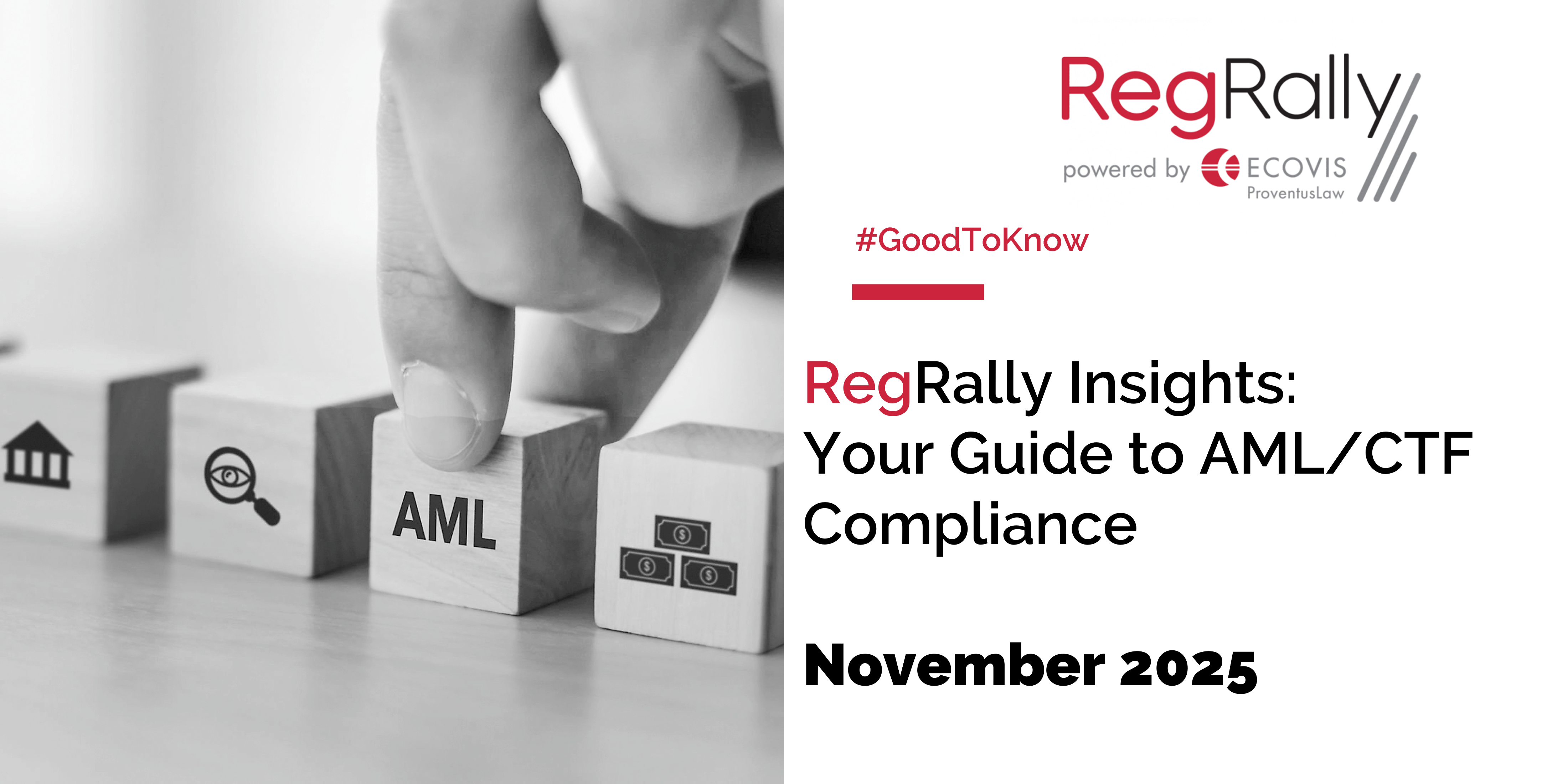Welcome to the monthly newsletter on Anti-Money Laundering and Counter-Terrorist Financing powered by ECOVIS ProventusLaw. It is dedicated to everyone who wants to understand the latest trends and developments, get tips from our experts and deepen their knowledge.
FATF Removes Four African Countries from Grey List
On 24 October 2025, the Financial Action Task Force (FATF) announced the removal of Burkina Faso, Mozambique, Nigeria, and South Africa from its “Grey List” of jurisdictions under increased monitoring. This decision recognises each country’s significant progress in strengthening AML/CTF and counter-proliferation financing frameworks. The FATF emphasised the importance of maintaining a risk-based approach to financial oversight while continuing to protect legitimate humanitarian and non-profit activities.
EBA Publishes First EU-Wide Report on White Labelling in Financial Services
On 14 October 2025, the European Banking Authority (EBA) released its first in-depth report on white labelling practices across the EU financial sector. The study reveals that around 35% of EU banks use white labelling models – where products or services are offered under a partner’s brand – particularly in payments, credit, and open banking.
While the model promotes innovation, market access, and financial inclusion, the EBA warns of emerging compliance, AML/CFT, consumer protection, and supervisory risks. Key issues include limited transparency over ultimate service providers, partner KYC dependence, and regulatory blind spots in non-outsourced arrangements.
To address these challenges, the EBA will integrate white labelling into its 2026 Union Supervisory Priorities, develop targeted supervisory tools, and enhance convergence across national authorities — without amending EU law.
EBA Highlights Ongoing AML/CFT Risks in Crypto-Asset Services
On 9 October 2025, the European Banking Authority (EBA) published a report on money laundering and terrorist financing (ML/TF) risks in crypto-asset services, based on supervisory cases across the EU. The findings reveal persistent vulnerabilities among crypto-asset service providers (CASPs), including unlicensed operations, jurisdictional arbitrage, weak AML frameworks, and opaque ownership structures. Some firms reportedly used multi-entity networks, offshore setups, or reverse solicitation to evade supervision.
The EBA identified deficiencies in customer due diligence, sanctions screening, Travel Rule compliance, and staff training, particularly among smaller players such as crypto-ATM operators. Authorities also noted high-risk partnerships and attempts by CASPs to acquire or align with banks and sanctioned entities to sustain activity.
The report underscores the importance of the MiCA framework, the upcoming AML Regulation (AMLR), and the Sixth AML Directive (AMLD6) in strengthening governance, beneficial ownership transparency, and cross-border coordination. Until the EU Anti-Money Laundering Authority (AMLA) becomes fully operational in 2028, national regulators will remain primarily responsible, with the EBA and ESMA overseeing supervisory convergence related to crypto.
EBA Reports Progress and Remaining Gaps in AML/CFT Supervision Across the EU Banking Sector
The European Banking Authority (EBA) has published its final assessment of how EU and EEA supervisory authorities have strengthened anti-money laundering and counter-terrorist financing (AML/CFT) oversight in the banking sector. The review highlights notable progress toward a risk-based supervisory approach, with most authorities implementing structured strategies, supervisory manuals, and improved domestic and cross-border coordination.
Despite these advancements, deficiencies persist in several jurisdictions. Some supervisory strategies are insufficiently detailed or not fully aligned with national ML/TF risk assessments. Additionally, cooperation between AML and prudential supervisors remains limited, and cross-border information exchange remains uneven.
The findings will serve as a baseline for the upcoming EU Anti-Money Laundering Authority (AMLA), which aims to enhance consistency and effectiveness of AML/CFT supervision across the Union.
MROS Expands Money Laundering Typology Report with Focus on Professional Enablers
The Money Laundering Reporting Office Switzerland (MROS) has released an updated Typology Report, broadening its catalogue of real-world money laundering cases. The latest edition places greater emphasis on the role of professional intermediaries and service providers – including lawyers, fiduciaries, trustees, and insurance intermediaries – in facilitating or inadvertently enabling illicit financial flows.
The report introduces nine new typologies illustrating how mechanisms such as safe deposit boxes, attorney escrow accounts, and nominee ownership structures are used to obscure beneficial ownership. High-risk areas include real estate, precious metals, art, and life insurance, often involving complex transactions that span multiple layers and cross international borders.
Common manipulation techniques include document falsification, misuse of legal instruments, and opaque fiduciary mandates. Several cases also reveal intersections between money laundering, sanctions evasion, corruption, and organised crime, underscoring the interconnected risks posed by professional enablers across sectors.
EBA Releases 2026 Work Programme, Refocusing on Prudential and MiCA Supervision
The European Banking Authority (EBA) has published its 2026 Work Programme, outlining its key supervisory and regulatory priorities for the year. The plan marks a strategic transition as anti-money laundering (AML) oversight shifts to the newly established EU Anti-Money Laundering Authority (AMLA), allowing the EBA to refocus on prudential supervision and MiCA implementation.
Key developments include:
- The EBA’s AML/CFT coordination mandate will conclude in 2026, transferring responsibilities to AMLA and initiating centralised EU-level AML supervision.
- Under the MiCA Regulation, the EBA will gain direct supervisory powers over issuers of significant asset-referenced (ARTs) and e-money tokens (EMTs), particularly those with cross-border or third-country exposure.
- The EBA will conduct its first peer review on national authorities’ management of MiCA white papers, investor disclosures, and redemption rights.
- Broader monitoring will cover DeFi, tokenisation, BigTech financial activities, and commercial bank-issued digital settlement assets.
- Additional resources will be allocated to MiCA supervision, underscoring the EBA’s commitment to robust oversight of the EU crypto-asset market.
EBA’s 2024 Report Highlights Ongoing Progress and Challenges in EU Supervisory Convergence
The European Banking Authority (EBA) has released its 2024 Report on Supervisory Convergence, detailing advances in aligning supervisory practices across the European Union. The report underscores the EBA’s commitment to fostering consistent, effective, and resilient supervision among national competent authorities, with focus areas including prudential oversight, resolution and crisis management, digital finance, consumer protection, and AML/CFT.
Key progress was achieved through enhanced cooperation mechanisms, cross-border coordination, and the development of EU-wide supervisory guidance, particularly in preparation for the implementation of MiCA. The report also marks a first step toward operationalising recommendations from the EBA’s broader initiative to strengthen the efficiency and coherence of the EU’s supervisory architecture.
However, the EBA notes that disparities in supervisory intensity, data quality, and risk methodologies continue to challenge full convergence across the Union.
EBA Responds to European Commission’s Call for Advice on Key AMLA Implementation Mandates
On 30 October 2025, the European Banking Authority (EBA) published its response to the European Commission’s Call for Advice on six mandates to be adopted under the new EU Anti-Money Laundering Authority (AMLA) framework. The proposals outline a harmonised, risk-based, and proportionate supervisory approach across the EU, covering:
- Methodologies for assessing inherent and residual ML/TF risks;
- Criteria for selecting firms subject to AMLA’s direct supervision;
- Enhanced customer due diligence (CDD) requirements; and
- A common framework for classifying and sanctioning AML/CFT breaches.
The EBA underscores the importance of early institutional preparation, as these measures will establish the operational foundation for EU-wide AML/CFT implementation and enforcement under the AMLA regime.
FIU Latvia Launches EU-Funded Financial Intelligence and Knowledge-Sharing Platform
On 1 October 2025, FIU Latvia announced the completion of a major EU Recovery Fund–financed project establishing a “Cooperation Platform for Financial Intelligence and Knowledge Sharing.” The €1.8 million initiative (with €1.5 million in EU funding) delivers a secure, technologically advanced infrastructure to enhance the detection, analysis, and prevention of money laundering risks.
The platform enables secure data collection, processing, and inter-agency information sharing. It includes research and competence development facilities, communication and collaboration spaces, data analytics tools, and a hypothesis analysis system for investigations.
FIU Latvia highlighted that, given the growing complexity and cross-border nature of financial crime, the project marks a strategic shift toward proactive, technology-driven intelligence operations, strengthening cooperation between law enforcement, supervisory, and intelligence authorities to protect Latvia’s financial system.


 Newsletter Subscription
Newsletter Subscription